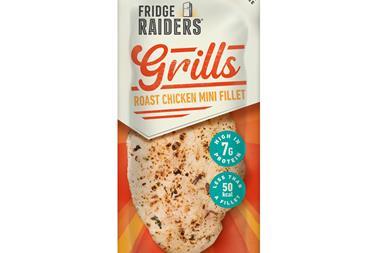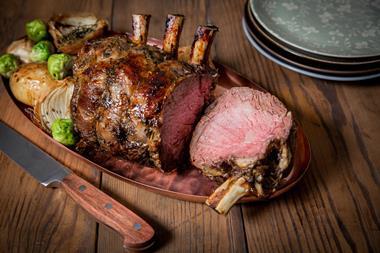Last week saw the publication of two apparently contradictory reports on the health risks of red meat. Julia Glotz assesses their potential impact on sales
As far as the popular press is concerned, there isn’t a foodstuff that doesn’t cause cancer and days later (often in the same paper) can’t cure it.
And so it was last week, although for once, the mixed messages weren’t entirely the papers’ fault. Instead, the finger could be pointed at two conflicting reports on the health risks or not associated with eating red meat.
First we had a research paper by the British Nutrition Foundation claiming that red meat consumption was not linked to heart disease and cancer. Any relief felt by burger fans was short-lived, however, because it was swiftly followed by the widely leaked report from the Scientific Advisory Committee on Nutrition, which urged those who ate an above-average amount of red meat to consider cutting their consumption if they wanted to reduce their risk of bowel cancer.
“So how much red meat CAN we eat?” the Daily Mail demanded. It’s a fair question and one whose answer could have serious ramifications not just for the red meat industry but also the nation’s health.
Every year, numerous single-issue interest groups commission and publish reports on the alleged benefits and risks of a whole range of foodstuffs, with red and processed meat particular favourites.
What marks out the SACN is its position as an important and well-respected advisory body to government, and the fact its findings have already informed policy.
Last Friday, the Department of Health announced it was advising people “for the first time” to consider cutting down on their consumption of red and processed meat to help reduce the risk of bowel cancer.
The recommendation has sparked considerable controversy, with detractors pointing out that the SACN report presents no conclusive evidence of a causal link between red meat consumption and increased risks of cancer. Yet while the BNF and its supporters took the view that this lack of conclusive evidence meant there wasn’t a robust enough basis to issue new health advice on red meat, the SACN decided there was enough to give precautionary advice.
“Overall, the available evidence suggests that red and processed meat intake is probably associated with increased colorectal cancer risk,” the SACN argued, although it admitted evidence for this was not clear-cut and that there was no evidence at all to quantify how much red meat someone would need to eat to have a higher risk of cancer.
Dr Carrie Ruxton, a public health nutritionist for the Meat Advisory Panel a newly founded body for health and nutrition advice, which is supported by meat industry bodies Bpex, Eblex and HCC warns that the health guidelines that have subsequently been issued by the Department of Health could change the behaviour of the wrong consumer groups.
Although men are far more likely to eat more red meat than the UK average of 70g a day and are therefore the primary group that should be reached by the new DH guidelines “it’s mostly mums who listen to health advice”, she says. “My concern is they will be cutting down on red meat just in case, and if women and children start eating less red meat, you will potentially have more instances of iron deficiency.”
The government should have been more targeted in its advice, agrees Bpex head of marketing Chris Lamb. “People are getting concerned when they shouldn’t need to be,” he says. “If I were Andrew Lansley, I would have gone out and tried to identify groups actually at risk and targeted them rather than just sending out a broad message.”
Other industry experts are also voicing concerns about how the new red meat eating guidelines have been communicated.
Clare Cheney, director general of the Provision Trade Federation, says the fact that most consumers will have read about DH’s advice thinking it stemmed from a new report on red meat when the SACN’s report was, in fact, about iron shows just how much of the 374-page report has got lost in translation. Two of the three core recommendations made by SACN (see box) received virtually no coverage, she points out.
And although it’s usually the media that receives the brunt of criticism when complex food health stories are reduced to “X causes cancer” headlines, the DH arguably didn’t help its cause on this occasion. By sending out a press release headed ‘red meat link to bowel cancer warning’, it undermined the otherwise balanced and “reasonable” advice being given out, argues Cheney.
The question is: what are consumers going to heed? Advice that they can eat “two standard beefburgers” or “one medium portion shepherds’ pie and a rasher of bacon” a day or the message that they should reduce their red meat consumption if they want to avoid cancer?
Against the backdrop of already declining red meat sales, it’s a loaded question. New figures from Kantar Worldpanel show sales of lamb were down 22% year-on-year in the four weeks to 23 January, while beef was down 12% and pork down 1%.
“When you link things to cancer, people are genuinely alarmed,” says Ruxton. “The message from SACN is ‘if you are a high meat eater, you should consider cutting down’, but the only message many people will be hearing is that they should reduce.”
Most industry sources nevertheless play down the potential impact of the advice on sales. “This is not the first time these types of calls have been made,” says a senior executive at one of the multiples. “I think British consumers are pretty inure to this by now.”
John Mercer, chief livestock adviser at the NFU, takes a similar line. “The majority of people enjoy eating red meat, and I’m not sure how many will take notice of the report,” he says, although he concedes “the timing wasn’t great because producers are under a lot of pressure at the moment”.
Lamb, however, worries a message to reduce red meat consumption could creep into public policy. “Over time, we could find that hospitals or schools are cutting the amount of red meat they serve, so the new guidelines could still have a long-term effect on the industry,” he notes.
Even if the new guidelines’ impact on red meat sales turns out to be minor on this occasion, the challenges highlighted by the two reports won’t go away. Not least because of the UK’s growing obesity crisis, clear and effective communication on health issues will be even more important in future.
If, as some have suggested, food-and-health stories have become commoditised to such an extent that the public now reacts with little more than a half-hearted shrug or a confused shake of the head to government advice, this should be cause for concern, not celebration.
Recommendations from SACN’s Iron & Health Report
1. While most people in the UK are iron replete, health professionals need to be alert to increased risk of iron deficiency anaemia in toddlers, girls and women of reproductive age (particularly those from low-income groups) and some adults aged over 65.
2. A healthy balanced diet will help people achieve adequate iron status. Such an approach is more important than consuming iron-rich foods at the same time as foods/drinks that enhance iron absorption or not consuming iron-rich foods with those that inhibit iron absorption.
3. Adults with relatively high intakes of red and processed meat (about 90g/day or more) should consider reducing intakes.



















No comments yet